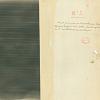 Last year, the earliest known recording of the human voice was discovered to have been made in France in the mid-19th century. This limited edition is beautifully packaged but seems superfluous; the brief recording is not exactly catchy and is available easily across the net as it is. I can only assume that there are more recordings made in the same way and it would make more sense to package them up together. Yet evidently only this one recording is interesting enough to be singled out for release.
Last year, the earliest known recording of the human voice was discovered to have been made in France in the mid-19th century. This limited edition is beautifully packaged but seems superfluous; the brief recording is not exactly catchy and is available easily across the net as it is. I can only assume that there are more recordings made in the same way and it would make more sense to package them up together. Yet evidently only this one recording is interesting enough to be singled out for release.
In 2008, many news sources carried the story of a recording made in 1860 of a woman singing the traditional song “Au Clair de la Lune.” The scratchy and frankly unearthly sounding recording was barely recognisable and later it was found that the recording had been digitised at the wrong speed; it was a man singing and not a woman. That man was Édouard-Léon Scott de Martinville, the inventor of the phonoautogram. This obscure recording device predates Thomas Edison’s phonograph by 17 years but instead of recording by putting indentations onto foil (Edison’s method), the phonoautogram recorded onto paper using soot from a smoking lamp. Scott de Martinville’s efforts lay buried in the archives of the Institute of France’s Academy of Sciences until last year when special software was designed to read the recording.
This 7” contains the full recording but that is not saying much. The 20 or so seconds that the recording lasts is anticlimactic; without knowing what it is I was listening to, this is only a piece of sonic debris. Even taking into account the importance of the piece, I do not feel that pressing Scott de Martinville’s recording onto a piece of vinyl is particularly fitting. The irony of releasing “Au Clair de la Lune” on the technology Edison invented seems to be lost on Parlortone. That said, the 7” format has allowed for some nice reproductions of the original notes and recordings on the sleeve and the historical account included here is far better than any of the articles published in the mainstream media. However, this is at the end of the day a scientific curio rather than a piece of art made to be enjoyed so needless to say the replay value is minimal.
Read More

